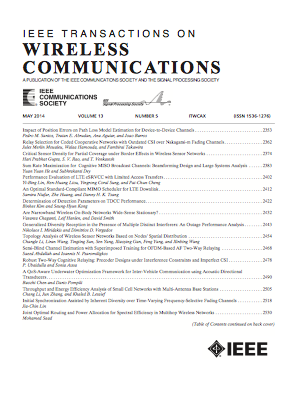协同干扰与抗干扰网络的多层发射ris辅助接收机
IF 10.7
1区 计算机科学
Q1 ENGINEERING, ELECTRICAL & ELECTRONIC
引用次数: 0
摘要
本文提出了一种多层主动-被动级联发射可重构智能表面(RIS)辅助接收机的新架构。我们的目标是提高天线尺寸的可扩展性和用户设备(UE)的能量效率,以及提高天线增益的幅度自由度。该架构集成了反射RIS,用于干扰和抗干扰场景的应用。基于恶意设备的不完全信道状态信息(CSI),我们提出了一个最大化UE的最坏情况频谱效率(SE)的问题,从而保证我们UE的SE,同时干扰非法UE的信号接收。为了解决公式化问题固有的非凸性,我们提出了一个交替优化框架,该框架将主问题分解为几个子问题。具体来说,我们统一离散不确定域以获得鲁棒CSI,使我们能够确定最优的接收向量。为了平衡计算复杂度和性能,我们提出了不同RIS模式下基站波束形成子问题和系数的解决方案。此外,为了有效地破坏恶意设备间通信,同时避免检测和定位,我们开发了一种包含无声干扰和非干扰协议的协作干扰模式。重要的是,该模式仔细地平衡了性能与CSI获取的开销。最后,仿真结果验证了所提算法的有效性,表明所提架构具有较好的抗干扰性能。本文章由计算机程序翻译,如有差异,请以英文原文为准。
Multi-Layer Transmitting RIS-Aided Receiver for Collaborative Jamming and Anti-Jamming Networks
In this paper, we propose a novel architecture for a multi-layer active-passive cascade transmitting reconfigurable intelligent surface (RIS)-aided receiver. We aim at enhancing the scalability of antenna dimensions and energy efficiency for user equipment (UE), as well as improving the amplitude freedom of antenna gain. This architecture integrates reflecting RIS for applications in both jamming and anti-jamming scenarios. We formulate a problem to maximize the worst-case spectral efficiency (SE) of the UE, based on imperfect channel state information (CSI) of the malicious device, thereby ensuring the SE of our UE while disrupting the signal reception of the illegal UE. To address the inherently non-convex nature of the formulated problem, we propose an alternating optimization framework, which decomposes the main problem into several subproblems. Specifically, we uniformly discretize the uncertain domains to obtain robust CSI, allowing us to determine an optimal receiver vector. To balance computational complexity and performance, we propose solutions for the subproblems of base station beamforming and coefficients with different patterns of RIS. Furthermore, to effectively disrupt malicious inter-device communication while avoiding detection and localization, we develop a collaborative interference pattern incorporating silent interference and non-interference protocols. Importantly, the pattern carefully balances performance with the overhead of CSI acquisition. Finally, simulation results validate the efficiency of the proposed algorithms, demonstrating that the proposed architecture achieves better jamming and anti-jamming performance.
求助全文
通过发布文献求助,成功后即可免费获取论文全文。
去求助
来源期刊
CiteScore
18.60
自引率
10.60%
发文量
708
审稿时长
5.6 months
期刊介绍:
The IEEE Transactions on Wireless Communications is a prestigious publication that showcases cutting-edge advancements in wireless communications. It welcomes both theoretical and practical contributions in various areas. The scope of the Transactions encompasses a wide range of topics, including modulation and coding, detection and estimation, propagation and channel characterization, and diversity techniques. The journal also emphasizes the physical and link layer communication aspects of network architectures and protocols.
The journal is open to papers on specific topics or non-traditional topics related to specific application areas. This includes simulation tools and methodologies, orthogonal frequency division multiplexing, MIMO systems, and wireless over optical technologies.
Overall, the IEEE Transactions on Wireless Communications serves as a platform for high-quality manuscripts that push the boundaries of wireless communications and contribute to advancements in the field.

 求助内容:
求助内容: 应助结果提醒方式:
应助结果提醒方式:


